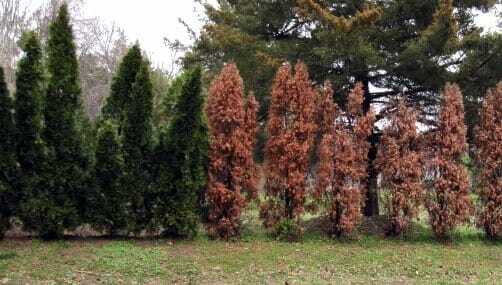


Arborvitae infected by Phyllosticta typically have blighted needle tips and/or discolored (pale green to yellow) needles that may appear desiccated. Based on submissions to the UMPDL, Phyllosticta can also be found on Leyland cypress ( ×Cupressocyparis leylandii), false-cypress ( Chamaecyparis spp.), Japanese cedar ( Cryptomeria) and juniper/red-cedar ( Juniperus spp.). Phyllosticta thujae was first described in 1989 and is thought to occur only on Thuja. thujae is the primary species encountered, but taxonomic studies are lacking. Little is currently known about the biology and ecology of Phyllosticta species on Thuja in North America. Based on samples submitted to the UMass Plant Diagnostic Laboratory (UMPDL), arborvitae needle blight is primarily the result of infection by two fungi: Phyllosticta and Pestalotiopsis. When trees are stressed, arborvitae needle blight can be significant threat to the long-term health of many trees in the landscape. Despite all this, Thuja do suffer from pest and pathogen issues in the landscape. They also exhibit rapid growth rates, resist drought well in most cases and have dense, overlapping branches of lustrous green needles. The wood is very decay-resistant and is prized for building materials that are subjected to harsh climates. Thuja species allocate significant resources to defense, and as a result, these trees can live for hundreds of years in their natural settings. One reason why species of Thuja are so popular in commercial horticulture is their resistance to insect and disease problems. The native Atlantic white-cedar ( Chamaecyparis thyoides) is not routinely planted because of its need for wet soils as an obligate wetland species. plicata × standishii) are less common but have become increasingly popular in recent years. plicata) and the hybrid Green Giant arborvitae ( T. occidentalis that offer unique and distinctive growth habits. Western red-cedar ( T. Additionallly, there are many other cultivars of T. Two cultivars in particular are especially popular: ‘Nigra’ (Dark American) for its fast growth and dark green color that persists through the winter months and ‘Smargd’ (Emerald Green) for its tight, columnar habit that creates a dense screen. In the northeast, the most common species of arborvitae in commercial and residential use is northern white-cedar ( Thuja occidentalis). However, Thuja are not true cedars (those belong to genus Cedrus). In southern New England, use of the common names arborvitae and cedar often refer to species of Thuja. Poor quality nursery stock, bad planting techniques and aggressive pruning are an unfortunate consequence of their popularity, but this is true for any oft-planted landscape ornamental (e.g. Due to their ubiquity on the landscape, arborvitae is often maligned as an unremarkable plant. When planted as a specimen tree, they can be a focal point or complementary componment in any landscape. Established in rows, arborvitae provides dense screening for privacy and border delineation.

Arborvitae ( Thuja spp.) are planted widely throughout the region by green industry professionals and homeowners as a landscape ornamental.


 0 kommentar(er)
0 kommentar(er)
